- Tropical East Asia’s rapid population growth and dramatic economic expansion over the past half century have taken a heavy toll on its natural resources.
- More than two-thirds of the region’s original forest cover has been cleared or converted for agriculture and plantations, while its flora and fauna have suffered dearly from a burgeoning trade in wildlife products—several charismatic species have gone extinct as a direct consequence of human exploitation.
- Nevertheless tropical East Asia remains a top global priority for conservation, supporting up to a quarter of the world’s terrestrial species.
An interview with ecologist Dr. Richard Corlett of National University of Singapore
Tropical East Asia’s rapid population growth and dramatic economic expansion over the past half century have taken a heavy toll on its natural resources. More than two-thirds of the region’s original forest cover has been cleared or converted for agriculture and plantations, while its flora and fauna have suffered dearly from a burgeoning trade in wildlife products—several charismatic species have gone extinct as a direct consequence of human exploitation. Nevertheless tropical East Asia remains a top global priority for conservation, supporting up to a quarter of the world’s terrestrial species.
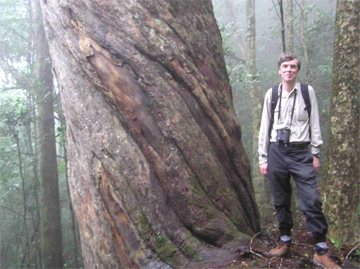
Richard Corlett in Yunnan Province, China |
A new book by Richard Corlett of National University of Singapore is the first to describe the terrestrial ecology of the entire East Asian tropics and subtropics, from southern China to western Indonesia. The Ecology of Tropical East Asia explores the elements that foster the region’s richness of plant and animal species as well as the threats facing biodiversity and conservation, including deforestation, hunting, climate change, logging and resource extraction. Corlett concludes that high human population densities, continued population growth, rural poverty, corruption, and globalized markets will present obstacles for conservation but that the chief aim for conservationists should be to safeguard existing protected areas.
“We need to work on all fronts, but the number one priority is to protect existing protected areas (national parks, nature reserves, forest reserves etc.) from further degradation,” he told mongabay.com. “All parks in the region are currently underfunded and their staff under-supported and underappreciated. In many cases this just requires more people on the ground to keep out hunters and illegal loggers. In other cases, conflicts with local people must be resolved.
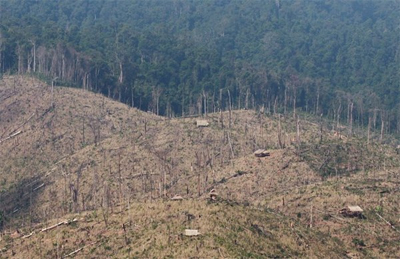 Forest conversion for rubber plantations in Northern Laos in January 2009 |
“If this is done, then a big chunk of the region’s biodiversity will make it through the next 50 years into a future region with declining human population and expanding forest cover – but possibly also devastating climate change.”
Corlett talked about his new book, his career, and the future of biodiversity in tropical East Asia in a June 2009 interview with mongabay.com.
An interview with ecologist Dr. Richard Corlett
Mongabay: What is your background and current field of study?
Richard Corlett: I am from London and did my first degree at Cambridge. While an undergraduate, a friend and I spent a summer in Southeast Asia doing ecological research and traveling, and I have been hooked on the region ever since. I did my PhD at the Australian National University, with fieldwork in Papua New Guinea, and have lived in tropical East Asia since then – almost 30 years. I have taught at Chiang Mai University in northern Thailand, then Singapore, then Hong Kong for almost 20 years, and I am now back in Singapore, as a Professor in the Department of Biological Sciences at the National University of Singapore. I have broad interests in terrestrial ecology and biodiversity conservation in tropical East Asia, with a current focus on plant-animal interactions, invasive species, urban ecology, and the potential impacts of climate change. On-going projects include the role of the Asian megafauna in seed dispersal (with Ahimsa Campos-Arceiz), the rehabilitation of degraded peatlands in Kalimanatan (with Mary Posa and others), and enhancement of native biodiversity in urban Singapore (with Hugh Tan).
Mongabay: Why did you decide to write a book about the ecology of tropical East Asia? Aren’t already there field guides covering this part of the world?
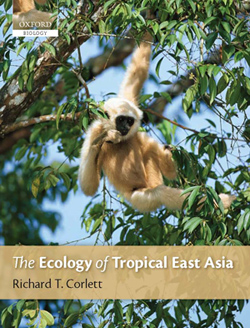
The Ecology of Tropical East Asia . The cover features a gibbon. Photo © Jurgen & Christine Sohns/FLPA |
Richard Corlett: I have had the idea in the back of my mind for years, but I finally decided to do it after having dinner with a group of Thai graduate students in Bangkok four years ago. They knew a great deal about their research sites and quite a lot about Thailand, but very little about the rest of the region and what other people were doing. The region is united by biology but divided by history and language. There have been several books on the tropical rainforests of Malaysia and Indonesia – including Tim Whitmore’s classic ‘Tropical Rain Forests of the Far East’ – but that is only a fraction of the region and only one of its major natural ecosystems. There are also books on some single countries. But there are no real biological boundaries between southern China in the north and western Indonesia in the south, or between the Andamans in the west and the Ryukyus, Philippines and Sulawesi in the east. The western land boundary of the book is the border between Myanmar and India – purely for convenience – but the other boundaries are biological, if not always very sharp. I called it “Tropical East Asia” rather than Southeast Asia, because modern political Southeast Asia excludes tropical China, which is part of the region, and includes eastern Indonesia, which is biologically very different. Coverage extends to 30 degrees north in China and the Ryukyu Islands so that I can cover the tropical-temperate transition.
It is not a field guide: it is the book you need to read before (and after) going into the field. My aim was to cover everything I thought those Thai graduate students should know about the terrestrial ecology and biogeography of the region they lived in, but in a readable way, so it would be accessible also to advanced undergraduates, specialists in other fields and to interested amateurs. I have been particularly careful to make it easy to read for non-native speakers of English, so technical jargon is used only where it is unavoidable or helps readability. The book is as comprehensive as I could make it in 262 pages. It starts with the environmental history of the region (plate tectonics, past climates, archaeology etc.), then moves on to physical geography (climate, soils, vegetation etc.), biogeography (including islands and the transitions to other regions), the ecology of plants (focusing on the stages in the plant life cycle) and animals (focusing on foods and feeding), energy and nutrients, and then ends with chapters on threats to biodiversity and conservation. There are lots of maps and photos, all black and white to cut costs.
Mongabay: Who is your target audience?
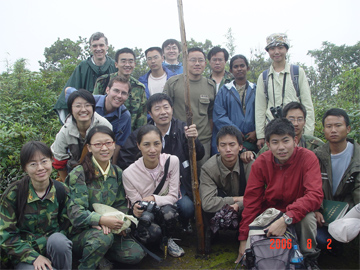 Corlett with students during a frugivory training course he ran with Chen Jin in Yunnan |
Richard Corlett: Graduate and advanced undergraduate students, professional ecologists, specialists in other fields, and interested amateurs. I assume some basic knowledge of ecology, but no knowledge of the region, although outsiders will need to use the maps a lot. Amateurs and specialists in other fields may want to skip some of the more technical bits, but most of the book should be of interest to anyone viewing this web site.
Mongabay: Generally, what is the state of natural ecosystems in the region? Are some on the brink and others in relatively good shape?
Richard Corlett: Mostly bad and getting worse. I have been in the region for almost 30 years and almost everywhere has lost forest and species over that period. Most remaining forest has been logged and/or lost its large mammals and birds to hunters. The small number of global extinctions is misleading, since so many species hang on in only a tiny fraction of their natural range. Nowhere in the region has all the species that used to be there. My favorite picture in the book is a bronze ritual vessel in the shape of a Sumatran rhino from Shandong Province, central China, around 3000 years ago. There are no rhinos in China anymore and only a few hundred left in the whole region.
Mongabay: What are the biggest threats to ecosystems and wildlife in tropical East Asia? What are the biggest obstacles to conservation efforts?
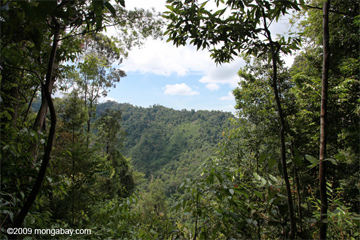 Small-scale forest clearing near Gunung Leuser national park in Sumatra. |
Mongabay: What do you see as the best way forward for conservation in the region? Are you optimistic that at least fragments of most ecosystems will be preserved for future generations?
Richard Corlett: We need to work on all fronts, but the number one priority is to protect existing protected areas (national parks, nature reserves, forest reserves etc.) from further degradation. All parks in the region are currently underfunded and their staff under-supported and underappreciated. In many cases this just requires more people on the ground to keep out hunters and illegal loggers. In other cases, conflicts with local people must be resolved. This will cost money and tends not to attract funding from NGOs and other international sources because it is unspectacular, but it is what needs doing most urgently. If this is done, then a big chunk of the region’s biodiversity will make it through the next 50 years into a future region with declining human population and expanding forest cover – but possibly also devastating climate change.
Mongabay: Is it practical to make human-dominated landscapes more accommodating for biodiversity?
Richard Corlett: This is the billion dollar question! Tropical forests are so different from current human-dominated landscapes that the general answer would have to be ‘no’. Non-forest areas in Singapore, where I now live, are dominated by invasive exotic species of trees, birds, earthworms and insects. It may, however, be possible to modify human-dominated landscapes in ways that make them friendlier to native forest biodiversity, and that is one of my current research areas. I suspect that the changes needed will be pretty drastic- a lot more tree cover and a lot more areas set aside for the restoration of native forest – but not necessarily impractical. Working on this is a good way to stay positive!
Mongabay: What are your thoughts on payments for ecosystem services on a means to finance conservation?
 Richard Corlett |
Richard Corlett: In the final chapter I consider sources of funding for conservation, including P.E.S. The success of PES schemes has been difficult to evaluate because “pure” PES is rare – there is usually another objective too, usually provision of income to the rural poor. I think that many – probably most – protected areas in the tropics should be receiving payments for water, from downstream farmers, industry or towns, but using PES to protect habitat outside protected areas has in practice proved difficult. PES makes most sense at the margins of profitability, when small payments can tip the balance in favor of conservation. China has two major schemes that could be considered PES: the Natural Forest Conservation Program, which pays forest enterprises to stop logging natural forests and to increase the plantation area, and the Grain to Green Program (also known as the Sloping Land Conversion Program), which pays farmers in key river catchments to convert cropland on steep slopes to grassland or forest. Both schemes have apparently already had large impacts on vegetation cover and the biodiversity benefits are likely to increase as more encouragement is given to the use of diverse native species in forest rehabilitation.
Carbon offset are a separate issue, with potentially huge amounts of money available, but also huge problems. At present we are all waiting to see where the post-Kyoto talks end up with this. Will REDD – the best option for conservation – be in any future international agreement? The ideal would be an international carbon scheme linked with some form of regional ‘biodiversity offset’ scheme, which gives greater value to biodiversity-rich carbon and stops the world being converted to fast-growing eucalyptus plantations.

The Ecology of Tropical East Asia
Amazon.com |
Amazon-UK |
Oxford University Press
Related articles
Commercial hunting may be the biggest threat to tropical rainforestsMay 1, 2007
New studies show ecological impact of the loss of rainforest animals to the bushmeat trade. Commercial hunting is decimating wildlife populations across the tropics and may be one of the gravest threats presently facing rainforests, reports a series of studies published in the May issue of the journal Biotropica. The research reveals that large-scale loss of wildlife is already affecting forest health and regeneration.














